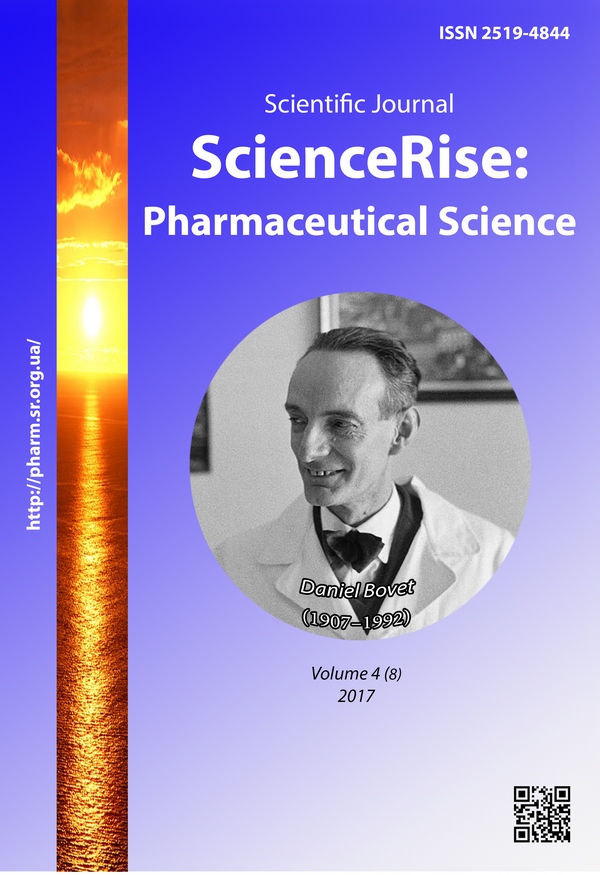The influence of the composition of liposomes on the encapsulation efficiency and the particle size when creating the liposomal form of cytochrome C
DOI:
https://doi.org/10.15587/2519-4852.2017.109003Keywords:
Cytochrome C, phospholipids, liposomes, homogenization, encapsulation degree, particle sizeAbstract
The influence of the liposomes’ composition on the encapsulation degree and particle size in the pharmaceutical formulation of the liposomal form of Cytochrome C is studied.
Aim: research of the effect of the composition of liposomes on the encapsulation efficiency and particle size when creating the liposomal form of Cytochrome C, as an agent for ophthalmic diseases therapy.
Methods. Liposomal form of Cytochrome C is obtained by high pressure homogenization. Encapsulation of Cytochrome C was carried out using chemical bonding method, based on the possibility of formation of chemical bond between the liposome bilayer components and the active pharmaceutical ingredient. To determine the encapsulation efficiency, HPLC method based on the gel filtration was developed. The determination was carried out using Shimadzu (Japan) chromatograph.
Results. The composition of liposome membrane that allows to obtain nanoparticles with high encapsulation degree of Cytochrome C – up to 95.88% and particle size in the range up to 150 nm – was determined.
Conclusion: The optimal composition of the liposome membrane containing Dipalmitoylphosphatidylglycerol and Phosphatidylcholine was studied for the further study of the given liposomal complex as a therapeutic remedy in ophthalmology.
It has been found that the optimal composition of liposomes is the ratio of Phosphatidylcholine and Dipalmitoylphosphatidylglycerol (1.2–4.0:1), ensuring the maximum encapsulation of Cytochrome C in liposomes.
Methods for determination of encapsulation degree of Cytochrome C were developed. Cytochrome C encapsulation was more than 95.0 %
References
- Mayer, H., König, H. (1987). Objective evaluation of cataract development under treatment with cytochrome C, sodium succinate, adenosine, nicotinamide and sorbitol. Fortsch. Ophthalmol, 84, 261–264.
- Krivtsova, I. M., Alekseeva, N. N. (1990). Tsitochrome C – phospholipid complex (preparation and study in the experiment). Cytochrome C and its clinical application, 74–76.
- Zhang, J., Guan, P., Wang, T., Chang, D., Jiang, T., Wang, S. (2009). Freeze-dried liposomes as potential carriers for ocular administration of cytochromecagainst selenite cataract formation. Journal of Pharmacy and Pharmacology, 61 (9), 1171–1178. doi: 10.1211/jpp.61.09.0006
- Shanskaya, A. I., Krivoruchko, B. I., Bulusheva, E. V. (1998). Pat. No. 2110990 RU. Liposomal'naya vezikula s Tsitokhromom C. MPK А61К9/127. No. 94027343/14; declareted: 14.07.1994; published: 20.05.1998.
- Alyautdin, R. N., Iezhitsa, I. N., Agarwal, R. (2014). Transcorneal drug delivery: prospects for the use of liposomes. Vestnik oftalmologii, 130 (4), 117–122.
- Liposomal preparations (2015). State Pharmacopoeia of Ukraine 2.0. Kharkiv: Derzhavne pidpryiemstvo «Ukrainskyi naukovyi farmakopeinyi tsentr yakosti likarskykh zasobiv», 1036–1038.
- Liposome drug products. Chemistry, manufacturing, and controls; Human pharmacokinetics and bioavailability;and labeling documentation. Guidance for industry (2015). U.S. Department of health and human servicesfood and drug administration center for drug evaluation and research (CDER). FDA. Available at: http://www.fda.gov/downloads/drugs/guidancecomplianceregulatoryinformation/guidances/ucm070570.pdf
- Ivanova, N. M. (2009). Pat. No. 44318 UA. Method for obtaining a liposomal cytochrome C. MPK A61K 9/00. No. u200905288; declareted: 27.05.2009; published: 25.09.2009, Bul. No. 18.
- Gorbenko, G. P., Molotkovsky, J. G., Kinnunen, P. K. J. (2006). Cytochrome c Interaction with Cardiolipin/Phosphatidylcholine Model Membranes: Effect of Cardiolipin Protonation. Biophysical Journal, 90 (11), 4093–4103. doi: 10.1529/biophysj.105.080150
- Mohn, E. S., Lee, J.-M., Beaver, C., Tobbe, G., McCarthy, S. M., O’Neil, E. et. al. (2014). Interactions of Cytochrome c with N-Acylated Phosphatidylethanolamine Lipids. The Journal of Physical Chemistry A, 118 (37), 8287–8292. doi: 10.1021/jp502063e
- Shobolov, D. L., Krasnopol'skiy, Yu. M., Ul'yanov, A. M. et. al. (2015). Pat. No. 022183 UA. Evraziyskoe patentnoe vedomstvo. Sposob polucheniya liposomal'noy formy tsitokhroma C. No. 201201592; declareted: 30.11.2012; published: 24.12.2015, 9.
- Katsai, O. G., Prokhorov, V. V., Grigoreva, G. S., Krasnopolsky, Yu. M. (2016). Development and validation of the method for determination of encapsulation efficiency of cytochrome C in liposomes. Farmatsevtychnyi zhurnal, 5, 69–75.
Downloads
Published
How to Cite
Issue
Section
License
Copyright (c) 2017 Oleksii Katsai, Olena Ruban, Yuriy Krasnopolskyi

This work is licensed under a Creative Commons Attribution 4.0 International License.
Our journal abides by the Creative Commons CC BY copyright rights and permissions for open access journals.








